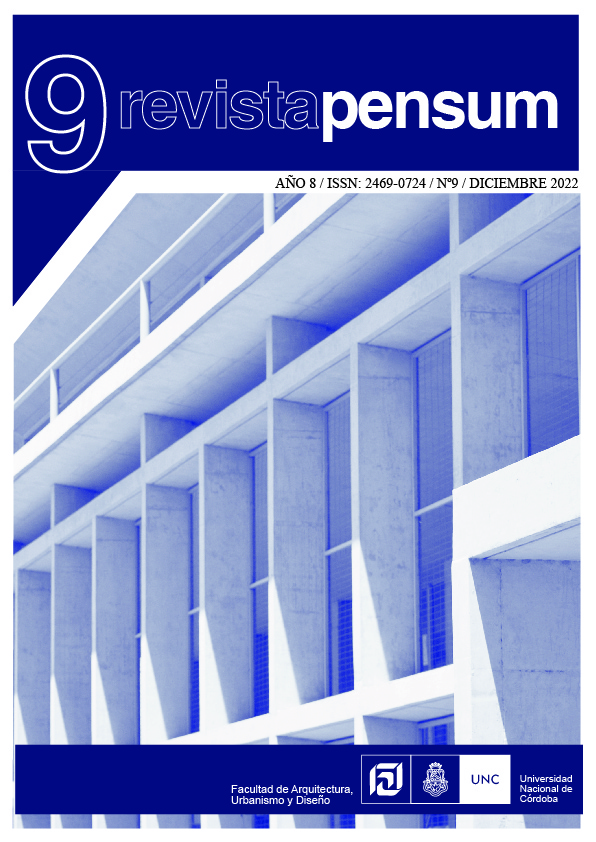Charitable societies, architecture and city
Rosario 1852-1910
DOI:
https://doi.org/10.59047/2469.0724.v8.n9.37209Keywords:
History, Architecture, Associative InstitutionAbstract
The present work aims to examine, from a crossroads of views, the global characteristics adopted by the urban-architectural space and the health, childhood and elderly care buildings of Rosario from the beginning of its modernization stage.
The analysis of the subject then is approached from two perspectives: one of them focused on the modes of political participation in the public space carried out by the Charitable Societies. And the other in the particularities of buildings and urban environments driven by them.
Understanding that these societies through their actions, transmitted the ideas of a political program, with which the local elite sought to establish itself hegemonically.
Developing for this a set of measures that aspired to reorder and modernize a society characterized by profound mutations.
Thus, the modernization process of the city that began in the mid-nineteenth century resulted in the segmentation of urban land and the materialization of spaces such as: the "Hospital de Caridad", the "Asilo del Buen Pastor", the "Hospicio de Huerfanos”, the “Maternity Asylums”, the “Juan Elena Blanco” school among others. Constructions that were from its insertion transforming and stressing the growth of the city.
References
AAVV (1925). La Verdad, órgano oficial del Círculo Obrero Rosario.
AAVV (1966). Revista Historia de Rosario, Año I.
Álvarez, J. (1998). Historia de Rosario (1689-1939), (2ª ed.) EMT y UNR
Álvarez, , J. (1910).Tercer Censo Municipal de Rosario de Santa Fe. Rosario, Argentina: Talleres Gráficos La República.
Armus , D. (1995). Enfermedad, ambiente urbano e higiene social, Rosario, incluido en Huelgas, Hábitat y Salud en el Rosario del novecientos. UNR.
Ansaldi ,W. (1992). Frívola y casquivana, mano de hierro en guante de seda. Una propuesta para conceptualizar el término oligarquía en América Latina en P. Funes (comp.), América Latina: planteos, problemas, preguntas, Bs. As.”. Bs. As., Argentina: Manuel Suarez
Baldoni, D., Voss, S. F. y Wortman, M., (1993).Las alianzas de familias. Bs. As., Argentina: Fondo de Cultura Económica.
Busaniche, J. (1971). Estampas del pasado. Bs. As., Argentina: Hyspamerica.
Carrasco, G. (1888). Primer Censo General de la Provincia de Santa Fe República Argentina, América del Sud. Bs. As., Argentina: Peuser.
Carrasco, G. (1883). Descripción geográfica y estadística de la provincia de Santa Fe, Rosario ,1883. Bs. As., Argentina: Peuser.
Comisión Nacional (1916). Censo Nacional de la República Argentina 1914. Bs. As., Argentina: Talleres Gráficos y Cía
Carrasco, E. y G. (1897). Anales de la ciudad de Rosario de Santa Fe. Bs. As., Argentina.: Peuser.
Di Tella, T. (1998). El Impacto Inmigratorio sobre el Sistema Político Argentino. Bs. As., Argentina: Estudios Migratorios Latinoamericanos, Año 4, No 12.
Falletti ,T., Sislian, F. (1997). Dominación política, redes familiares y clientelismo. Bs. As., Argentina.: Grupo Editor Universitario.
Follari, R: (1990) . Modernidad y posmodernidad. una óptica desde A. L., Rei. Bs. As., Argentina.: Aique Grupo Editor S.A
Gormaz y Carreras, J. (1858). Primer Censo General de la Provincia de Santa Fe. Copia manuscrita. CDMR.
González B. P., (2004). La pedagogía societaria y el aprendizaje de la nueva nación en el río de la Plata post-independentista. Tandil, Argentina: IEHS
Habermas J. (1989). The structural transformation of the public sphere”, Cambrige Mass, citado en el artículo de Hilda Sábato, Ciudadanía, participación política y formación de una esfera pública en Bs. As., 1850-1880. Bs. As., Argentina.: Revista Siglo XIX.
Megias, A. (1992). Los modos de hacer política en Santa Fe en la segunda mitad del siglo XIX. Rosario, escenario y protagonistas en Estudios sociales No 3.Rosario, Argentina: Revista Universitaria Semestral. UNR
Megias, A. (1996). La formación de una elite de notables-dirigentes. Rosario, 1860-1890. Rosario, Argentina: Editorial Biblios.
Vicuña Mackenna, B.(1971) Páginas de mi diario durante los años 1853-1855, en Busaniche, José Carmelo (Eds) (p.: 785-788). Estampas del pasado . Bs. As., Argentina Solar-Hachette.
Sábato, H. (1998). La política en las calles. Entre el voto y la movilización. Buenos Aires, 1862-1880. Bs. As., Argentina :Editorial Sudamericana.
Sábato, H. (2003). Ciudadanía, participación política y formación de una esfera pública en Bs. As., 1850-1880. Bs. As., Argentina :Revista Siglo XIX, pp. 46.
Socade Newton, L (1971). Diccionario Biográfico de Mujeres Argentinas. Bs. As., Argentina: Plus Ultra.
Downloads
Published
Issue
Section
License
Copyright (c) 2022 Analia Brarda

This work is licensed under a Creative Commons Attribution-ShareAlike 4.0 International License.
Authors who publish in this journal agree to the following terms:
a. Authors retain copyright and guarantee to the journal the right to be the first publication of the work as well as licensed under a Creative Commons Attribution-ShareAlike 4 license.
b. Authors may separately establish additional agreements for non-exclusive distribution of the version of the work published in the journal (e.g., placing it in an institutional repository or publishing it in a book), with an acknowledgement of its initial publication in this journal.
c. Authors are permitted and encouraged to disseminate their work electronically (e.g., in institutional repositories or on their own website) before and during the submission process, as this may result in productive exchanges, as well as earlier and greater citation of published work (See The Effect of Open Access).
d. 4.0 International Creative Commons Attribution-ShareAlike 4.0 License.












